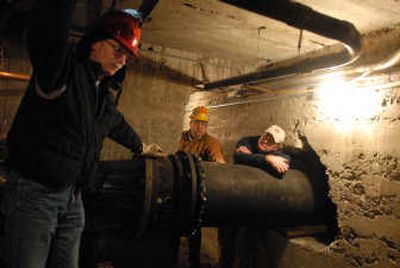Oct. 19 valve break nearly fatal

In the corner of the cellar of a century-old South Hill water pumping station, Bob Glasser was trapped as 27,000 gallons of water a minute blasted through a hole in the wall, preventing an exit.
By the time the 50-degree water stopped rising, it was about six inches from the ceiling and he and another trapped city of Spokane employee had to tilt their heads to breathe.
“I was pretty much resigned to the fact that I wasn’t going to make it,” Glasser said.
Glasser and Michael Judd were in the basement of the Lincoln Heights Booster Station at 23rd and Ray about 9:10 a.m. Oct. 19 when, just outside the building, the valve on the end of an 18-inch pipe shot off, causing water to inundate the station and pour down Ray Street.
“We were about this close to losing two people,” said Lynn Shupe, as he held out his hand showing the gap of a few inches between his index finger and thumb.
Shupe, the water department’s maintenance service supervisor, credits the water crew on hand for quickly shutting off other valves, pulling down a door and other actions that saved the two men’s lives.
This month, Mike Wilhelm, who has worked in the water department for 24 years, is the city’s employee of the month, in part for actions he took that day. Wilhelm and Bert Cheney, water service foreman, hooked a chain up to a truck and tore off a door, greatly lowering the water level in the building.
A state Labor and Industries investigation on the incident is under way. A city report, obtained through a public information request, says workers responded appropriately and that there were no violations of rules that led to the men being trapped. But the report makes six recommendations to prevent such incidents in the future.
They include a new rule that will require a more complete shutdown during future work at pumping stations. Conventional doors, which opened to the inside and thus wouldn’t function as water pressure built up, will be replaced by roll-up doors. More formal training will occur.
The water crew was at the site to replace 100-year-old pipes leading into the pumping station. The Lincoln Heights station transfers water up the South Hill. When the pipe broke, that meant the water south of the station could flow toward the busted pipe. Water crews quickly turned off three valves, but couldn’t reach another because it was under water. Instead, crews had to shut the flow off at 29th Avenue.
Soon after the break, Glasser said he realized his only way out was blocked by the shooting water.
Knowing it would be impossible to walk through the flow, he tried anyway, only to get knocked down.
“My first reaction was, this was my only chance,” Glasser said.
At another point, Judd was hanging on to a small pipe near the hole and couldn’t get his footing. Glasser grabbed him and helped him move to solid ground. Later, Judd, who is thinner than Glasser, was able to move to another section of the basement where he could talk through the floor to other employees, who sent down hoses for them to use to breathe if the water went higher.
Glasser and Judd, who were trapped for about 40 minutes before they could escape, were taken to Sacred Heart Medical Center and treated for hypothermia and back at work the next week.
The incident occurred on a Friday. The Monday after, Glasser was back in the pump station basement, helping to clean it up. “I maybe have a little bit of neck pain that I didn’t have before,” but it’s not disabling, Glasser said. “I just felt that I wanted to get right back down there. It didn’t bother me. It may have affected the other guys a little bit more than me.”
The pump station has been down since the incident, leaving a pump station at 14th and Grand as the only one available to serve most of the South Hill.
“It was questionable whether 14th and Grand would be able to keep up,” Shupe said.
But it has. This week, the city put two of the eight pumps at Lincoln Heights back online for the first time since Oct. 19.
Attempts to reach Judd were unsuccessful.
Glasser said he has been impressed with the city’s action that day and after.
“The guys that I work with that were on site with me, they were my saviors,” Glasser said. “They just have an incredible knowledge of it. Without looking at a map, they knew which (valves) to shut down.”
Acting Public Works Director Dave Mandyke said the pipe that shot off was installed by a contractor in 2000. Mandyke said the contractor hasn’t been contacted by the city.
In the aftermath, city officials and union leaders have agreed that the department should hire a full-time safety officer.
“That’s one of those events that shakes you to the roots,” Mandyke said. “It was a very close miss.”